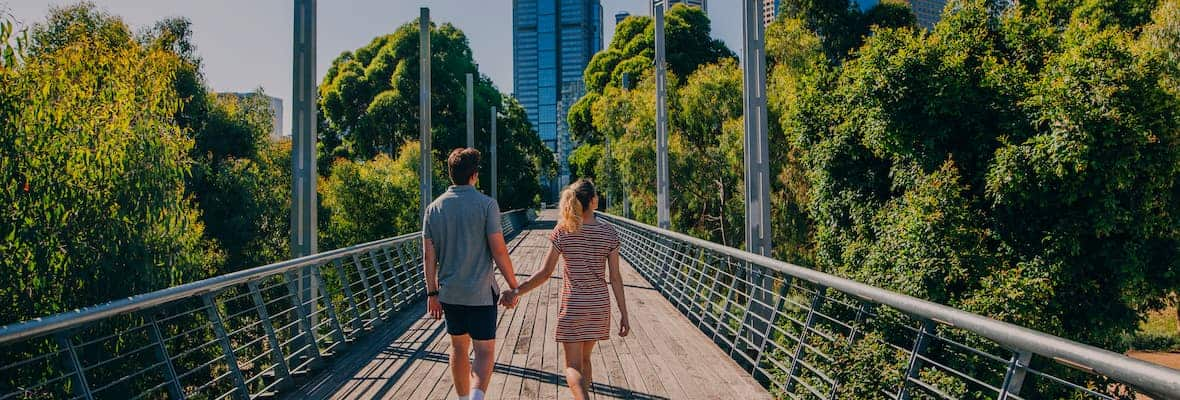Whether you prefer strolling around a big country town, soaking up the sun at stunning beaches or getting your culture kick at a contemporary art gallery, there's plenty to visit in Australia.
Domestic tourism in Australia is finally getting back on track after a few rocky years during the pandemic.
So with Aussies eagerly returning to travel, we wanted to know what’s the best Australian city to visit, which are the worst cities in Australia to visit, and why.
We surveyed more than 1,000 Australians 18 years and over about their opinions on domestic travel to better understand trends and behaviours and see how they impact the overall industry.
Quick Stats
- Melbourne was voted the top capital city holiday destination by the majority of respondents
- Darwin was voted by the majority of respondents to be at the bottom of their travel list
- More than three-quarters of respondents said domestic travel has gotten more expensive since the pandemic
- More than 40% of respondents have travelled domestically in the last six months
- The majority of respondents spent between $500 and $1,000 on their last domestic holiday
Australian Tourism Statistics
Since the peak of COVID-19, domestic tourism in Australia has been back on the rise.
In the year to June 2023, there was a 57% increase in spending for domestic trips compared to the same period the year before. [1]
Across Australia in the year to June 2023, there were [1]:
- 111 million domestic visitors
- $108 billion spent
- 405 nights spent travelling
More than half of the total money spent in the year to June 2023 for domestic travel was spent on food, drink and accommodation. The second most expensive travel cost was transportation (including taxis, petrol, public transport, rental cars and rideshares) followed by airfares and shopping. [2]
Travel Outside of Capital Cities
With amazing attractions such as the South Australian Museum in Adelaide or the Lone Pine Koala Sanctuary in Brisbane, it's understandable why people flock to capital cities.
But even though tourism spending can be saturated in capital cities, there is plenty of spending happening in other parts of the country. In the year to June 2023, 62% of domestic visits happened outside of capital cities and Gold Coast. [2]
For instance, Far North Queensland's natural beauty, the Great Barrier Reef, is a major economic benefit, attracting more than two million tourists each year and supporting more than 60,000 jobs. [3]
Plus, despite being 440 kilometres out of Alice Springs and arguably one of the more difficult tourist attractions to get to, Uluru-Kata Tjuta National Park saw an average of 16,086 visitors a month over winter. [4]
Meanwhile, day trips from capital cities to nearby locations are also popular among travellers. This could include heading to the historic seaside port in Fremantle from Perth or the Blue Mountains from Sydney in New South Wales.
COVID-19 Impacts
Before COVID-19, Melbourne was well and truly the preferred holiday destination for domestic travellers in Australia. But when the pandemic hit, lockdowns and mandatory isolations meant Melbourne’s popularity plummeted and the Gold Coast in Queensland took first place. [5]
In June 2023, Gold Coast became the third preferred domestic travel destination behind Sydney and Melbourne. [5]
Now it’s time to see what else has changed in light of the pandemic, and which city has taken over as the top holiday destination in the country.
Australian Domestic Tourism Survey Results
For more information on how Australians holiday in their own backyard, check out our survey results below.
How long ago was your last domestic holiday in Australia?^
^Due to how the figures are rounded within the survey data, numbers may not add up to exactly 100%
The majority of those surveyed were regular travellers with more than 40% of respondents saying their last domestic holiday in Australia was less than six months ago.
Meanwhile, almost a quarter of respondents said they hadn’t taken a domestic holiday in more than two years.
Of the states surveyed, South Australian respondents were the most likely to have not been on a domestic holiday for more than two years according to almost a third of those surveyed.
What was the duration of your last domestic holiday?^
^Due to how the figures are rounded within the survey data, numbers may not add up to exactly 100%
Most of those surveyed said their last domestic holiday was around four to seven days, while the next most common response was between one to three days.
Overall, Australian respondents were least likely to go on a domestic holiday for longer than two weeks.
In the year to June 2023, Australian domestic travellers spent an average of four nights on their getaway. [1]
Those aged over 65 who were surveyed were more likely than younger respondents to have a longer domestic holiday.
More than a quarter of respondents in that age group said they stayed on their last domestic holiday for a week to two weeks, while 17% said they stayed for more than two weeks.
How much did you spend on your last domestic holiday (including flights, accommodation and spending money)?^
^Due to how the figures are rounded within the survey data, numbers may not add up to exactly 100%
For a domestic holiday, respondents most commonly paid between $500 and $1,000 for the entire trip.
This was closely followed by 28% of respondents saying they had a budget of $1,000 to $2,000 for their last domestic holiday.
Women who were surveyed were more likely than male respondents to spend less than $500 on a domestic holiday. While men were slightly more likely to spend more than $4,000 on their holiday.
One in ten respondents over the age of 65 said they spent $4,000 or more on their last domestic holiday. This was more than three times the number of respondents aged 18 to 29 who said they spent more than $4,000 on their last getaway.
Meanwhile, those who travel for longer, tend to spend more. This was made clear with the 65 and over age group of respondents who were both the most likely to travel for the longest period of time, and the most likely to spend the most.
In the year to June 2023, the average Australian domestic traveller spent around $972 on their entire trip, or $268 per night. [1]
In your life, which Australian capital cities have you visited for a holiday?*
*Respondents were able to select more than one response
Sydney and Melbourne were the two most visited capital cities, according to almost two-thirds of those surveyed.
Brisbane was the third most visited city for respondents with almost 60% saying they’d holidayed there at one point in their lives.
Meanwhile, Darwin was the capital city where the least amount of respondents had visited with just 16% saying they had spent a holiday there.
Women respondents were slightly more likely to have visited Sydney in their lives, while men respondents were slightly more likely to have visited Adelaide for a holiday.
If you had to pick, which is your favourite Australian capital city to visit for a holiday?^
^Due to how the figures are rounded within the survey data, numbers may not add up to exactly 100%
Melbourne was voted the favourite capital city for a holiday by the majority of those surveyed.
This was closely followed by Sydney and Brisbane where both locations had one in five respondents each saying it was their favourite capital city to visit.
Those aged 18 to 29 were the most likely respondents to say Brisbane was their favourite capital city to visit on holiday, according to a quarter of the age group of respondents.
Meanwhile, Melbourne was the top vote for respondents aged 30 to 64, while those aged 65 and over were most likely to say Sydney was their favourite capital city to holiday in.
Why is it your favourite capital city to visit?*
Rank |
Reason |
Percentage of respondents |
|---|---|---|
1st |
Beaches |
63.73% |
2nd |
Climate |
50.98% |
3rd |
Restaurants and cafes |
47.55% |
4th |
Ability to relax or disconnect |
46.08% |
5th |
Tourist attractions and famous landmarks |
38.73% |
6th |
Shopping |
35.78% |
7th |
Sporting activities (surfing, hiking, scuba) |
14.71% |
8th |
Art and culture |
14.22% |
9th |
Nightlife |
13.24% |
10th |
Other |
6.86% |
Rank |
Reason |
Percentage of respondents |
|---|---|---|
1st |
Tourist attractions and famous landmarks |
60.80% |
2nd |
Restaurants and cafes |
50.25% |
3rd |
Beaches |
42.71% |
4th |
Shopping |
40.70% |
5th |
Ability to relax or disconnect |
33.67% |
6th |
Climate |
30.15% |
7th |
Art and culture |
27.64% |
8th |
Nightlife |
19.10% |
9th |
Sporting activities (surfing, hiking, scuba) |
13.07% |
10th |
Other |
7.54% |
Rank |
Reason |
Percentage of respondents |
|---|---|---|
1st |
Restaurants and cafes |
66.94% |
2nd |
Shopping |
52.24% |
3rd |
Art and culture |
46.12% |
4th |
Tourist attractions and famous landmarks |
37.14% |
5th |
Ability to relax or disconnect |
31.02% |
6th |
Nightlife |
18.78% |
7th |
Beaches |
16.73% |
8th |
Sporting activities (surfing, hiking, scuba) |
15.10% |
9th |
Climate |
14.69% |
10th |
Other |
5.31% |
Rank |
Reason |
Percentage of respondents |
|---|---|---|
1st |
Ability to relax or disconnect |
63.55% |
2nd |
Tourist attractions and famous landmarks |
57.94% |
3rd |
Restaurants and cafes |
38.32% |
3th |
Climate |
38.32% |
4th |
Art and culture |
30.84% |
5th |
Shopping |
14.95% |
6th |
Beaches |
13.08% |
7th |
Other |
11.21% |
8th |
Sporting activities (surfing, hiking, scuba) |
7.48% |
9th |
Nightlife |
5.61% |
Rank |
Reason |
Percentage of respondents |
|---|---|---|
1st |
Tourist attractions and famous landmarks |
60.47% |
2nd |
Ability to relax or disconnect |
53.49% |
3rd |
Climate |
51.16% |
4th |
Art and culture |
32.56% |
5th |
Beaches |
25.58% |
6th |
Restaurants and cafes |
23.26% |
7th |
Shopping |
11.63% |
7th |
Sporting activities (surfing, hiking, scuba) |
11.63% |
7th |
Nightlife |
11.63% |
8th |
Other |
9.30% |
Rank |
Reason |
Percentage of respondents |
|---|---|---|
1st |
Beaches |
51.65% |
2nd |
Climate |
50.55% |
3rd |
Tourist attractions and famous landmarks |
49.45% |
4th |
Ability to relax or disconnect |
47.25% |
5th |
Restaurants and cafes |
39.56% |
6th |
Art and culture |
15.38% |
7th |
Shopping |
14.29% |
8th |
Other |
8.79% |
9th |
Nightlife |
7.69% |
10th |
Sporting activities (surfing, hiking, scuba) |
6.59% |
Rank |
Reason |
Percentage of respondents |
|---|---|---|
1st |
Tourist attractions and famous landmarks |
63.27% |
2nd |
Art and culture |
48.98% |
3rd |
Ability to relax or disconnect |
44.90% |
4th |
Restaurants and cafes |
38.78% |
5th |
Shopping |
32.65% |
6th |
Climate |
24.49% |
7th |
Nightlife |
8.16% |
8th |
Other |
6.12% |
9th |
Sporting activities (surfing, hiking, scuba) |
4.08% |
10th |
Beaches |
2.04% |
Rank |
Reason |
Percentage of respondents |
|---|---|---|
1st |
Restaurants and cafes |
50.67% |
2nd |
Ability to relax or disconnect |
48.00% |
3rd |
Tourist attractions and famous landmarks |
40.00% |
4th |
Art and culture |
36.00% |
5th |
Beaches |
29.33% |
6th |
Climate |
26.67% |
7th |
Shopping |
25.33% |
8th |
Other |
21.33% |
9th |
Sporting activities (surfing, hiking, scuba) |
12.00% |
10th |
Nightlife |
6.67% |
*Respondents were able to select more than one response
Respondents who said Melbourne was their favourite capital city to visit said it was because of the restaurants and cafes. This was followed by shopping, art and culture.
For those who voted for Brisbane, the top reason was the beaches. However, despite several non-swimming beaches, including the man-made beach at South Bank and of course the iconic Brisbane River, beachgoers would have to travel from Brisbane to Sunshine Coast, Gold Coast or Moreton Bay for their nearest swim.
Respondents also said they loved Brisbane's climate, restaurants and cafes.
Meanwhile, those who voted for Sydney said it was because of the restaurants, cafes and beaches. But the biggest reason people loved Sydney was for the famous landmarks and tourist attractions such as the Sydney Opera House and the Sydney Harbour Bridge.
Of all the coastal capital cities, Perth had the most number of respondents saying the beaches were their main attraction.
Hobart was the only capital city where the majority of respondents who chose it as their favourite city said it was because of the ability to relax or disconnect.
Which Australian capital city are you least likely to visit on a holiday?^
^Due to how the figures are rounded within the survey data, numbers may not add up to exactly 100%
The majority of respondents said that of all the capital cities, Darwin would be at the bottom of their travel list, according to more than a quarter of those surveyed.
This was followed by Canberra with 21% saying it was at the bottom of their travel list, and Perth which was chosen by 11% of respondents.
For South Australian respondents, the majority of those surveyed (38%), said Canberra would be their least likely holiday destination of all the capital cities.
Why is this city at the bottom of your travel list?^*
Rank |
Reason |
Percentage of respondents |
|---|---|---|
1st |
Other |
35.21% |
2nd |
Lack of things to do |
28.17% |
3rd |
Too expensive |
18.31% |
4th |
Not enough culture |
16.90% |
5th |
Climate |
15.49% |
5th |
Too busy |
15.49% |
6th |
Too hard to get to |
7.04% |
7th |
Too quiet |
0.00% |
Rank |
Reason |
Percentage of respondents |
|---|---|---|
1st |
Too busy |
50.53% |
2nd |
Too expensive |
49.47% |
3rd |
Other |
13.68% |
4th |
Too hard to get to |
12.63% |
5th |
Climate |
10.53% |
6th |
Lack of things to do |
8.42% |
7th |
Too quiet |
5.26% |
8th |
Not enough culture |
1.05% |
Rank |
Reason |
Percentage of respondents |
|---|---|---|
1st |
Too expensive |
38.27% |
2nd |
Too busy |
32.10% |
3rd |
Other |
29.63% |
4th |
Climate |
20.99% |
5th |
Lack of things to do |
19.75% |
6th |
Not enough culture |
7.41% |
7th |
Too hard to get to |
7.41% |
8th |
Too quiet |
1.23% |
Rank |
Reason |
Percentage of respondents |
|---|---|---|
1st |
Too hard to get to |
35.80% |
2nd |
Climate |
30.86% |
3rd |
Lack of things to do |
28.40% |
4th |
Too quiet |
22.22% |
5th |
Too expensive |
17.28% |
6th |
Other |
9.88% |
7th |
Not enough culture |
7.41% |
8th |
Too busy |
4.94% |
Rank |
Reason |
Percentage of respondents |
|---|---|---|
1st |
Climate |
48.74% |
2nd |
Too hard to get to |
44.77% |
3rd |
Lack of things to do |
28.88% |
4th |
Too expensive |
16.97% |
5th |
Other |
11.91% |
6th |
Not enough culture |
10.11% |
7th |
Too quiet |
7.58% |
8th |
Too busy |
1.08% |
Rank |
Reason |
Percentage of respondents |
|---|---|---|
1st |
Too hard to get to |
66.09% |
2nd |
Too expensive |
24.35% |
3rd |
Lack of things to do |
16.52% |
4th |
Too quiet |
10.43% |
4th |
Other |
10.43% |
5th |
Not enough culture |
6.09% |
6th |
Climate |
4.35% |
7th |
Too busy |
0.87% |
Rank |
Reason |
Percentage of respondents |
|---|---|---|
1st |
Lack of things to do |
58.14% |
2nd |
Too quiet |
25.58% |
3rd |
Too expensive |
22.33% |
4th |
Climate |
20.47% |
4th |
Not enough culture |
20.47% |
5th |
Other |
13.49% |
6th |
Too hard to get to |
10.70% |
7th |
Too busy |
5.58% |
Rank |
Reason |
Percentage of respondents |
|---|---|---|
1st |
Lack of things to do |
56.41% |
2nd |
Too quiet |
26.92% |
3rd |
Too hard to get to |
24.36% |
4th |
Other |
12.82% |
5th |
Not enough culture |
12.82% |
6th |
Too expensive |
10.26% |
7th |
Climate |
7.69% |
8th |
Too busy |
1.28% |
*Respondents were able to select more than one response
Of the respondents who chose Darwin as the capital city they were least likely to travel to, almost half said that it was because of the climate and because it was too hard to get to.
For respondents who chose Canberra, the top reason was because there was a lack of things to do. This was followed by it being too quiet and too expensive.
Meanwhile, the majority of respondents who said they were least likely to travel to Sydney said it was because it was too busy.
More than two thirds of those surveyed said that they didn’t choose to visit Perth because it was too hard to get to. This was the most common response given by respondents of all the capital cities.
Do you think domestic travel has become more or less expensive since COVID-19?^
^Due to how the figures are rounded within the survey data, numbers may not add up to exactly 100%
More than three-quarters of those surveyed said they believed domestic travel has become more expensive since COVID-19.
Those aged 18 to 29 were the most likely age group surveyed to say there had been no change in the cost of domestic travel since the pandemic, according to more than one in ten respondents.
Meanwhile, the cost rise was felt more by those surveyed aged 65 and over with 83% saying the cost of domestic travel was now more expensive than in years before the pandemic and interstate lockdowns.
Since COVID-19, are you more or less likely to travel domestically?^
^Due to how the figures are rounded within the survey data, numbers may not add up to exactly 100%
More than half of those surveyed said there’s been no change to their likelihood of travelling domestically since COVID-19.
Women respondents were slightly more likely than male respondents to say they would be less likely to travel domestically since COVID-19.
Meanwhile, more than half of respondents aged 65 and over said there was no change to their travel plans in light of the pandemic.
Do you think the rate of domestic travel in Australia has returned to what it was before the pandemic?^
^Due to how the figures are rounded within the survey data, numbers may not add up to exactly 100%
More than 40% of those surveyed had the opinion that domestic travel was now back to what it was before the pandemic.
However, 29% of respondents believed there are now fewer people travelling compared to pre-COVID.
Those surveyed in Victoria were the most confident that the rate of domestic travel in Australia had now returned to what it was before the pandemic, according to 46% of respondents.
This is compared to just a third of respondents from South Australia who gave the same answer.
Key Takeaways
Bigger Cities Top the Travel List
Melbourne was voted the top capital city that respondents would want to holiday in. This was thanks to its restaurants, cafes, shopping, such as at the Queen Victoria Market, art and culture.
Meanwhile, respondents voted Brisbane and Sydney as their second choice for the best cities in Australia.
Those surveyed said this was because of the beaches, restaurants and cafes as well as Brisbane’s climate and Sydney’s tourist attractions.
However, not everyone loves a holiday to the big city. Of those surveyed who ranked Melbourne, Sydney or Brisbane at the bottom of their travel list said it was generally because the cities were too busy or too expensive.
Darwin’s Climate Holds It Back
Darwin in the Northern Territory was voted by the majority of respondents as the capital city at the bottom of their travel list.
Almost half of those who chose Darwin as their least likely travel destination said it was because of the climate and that it was too hard to get to.
Meanwhile, one in five respondents said Canberra was at the bottom of their list. This included 38% of all South Australian respondents who put Canberra in last place on their travel list.
The main reason for more than half of respondents who chose Canberra as their least favourite city was because of a lack of things to do.
Perth came in third place for the least likely holiday spot of all the capital cities according to those surveyed. Two-thirds of respondents said this was because it was too hard to get to.
COVID-19 Impacts Travel Cost
The majority of respondents said they spent between $500 and $1,000 on their last domestic holiday in Australia.
However, more than three-quarters of respondents said the cost of travelling domestically has gotten more expensive since COVID-19 happened.
Most of those surveyed said they believed domestic travel is back to what it was before the pandemic.
It comes as more than 40% of respondents said they had travelled in the past six months.







